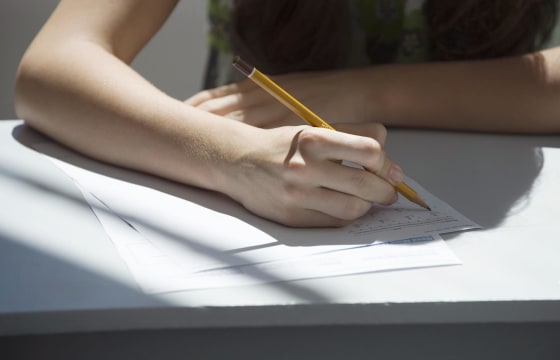In November 2023, Karen Jensen, a Utah elementary school teacher, shared an Instagram reel from her classroom labeled, “THIS IS HOW WE GET EXCITED FOR MATH IN THE MORNING.”
In it, she leads her students in a short activity where they rhythmically move their math books in the air in time to the song “The Circle of Life” from The Lion King. They finish with one strong beat where they all drop their books to their desks.
Since then, the reel has gone viral, with more than 18 million views, almost 500,000 likes, more than 6,000 comments and nearly 200,000 shares.
There are good reasons the reel has received so much attention.
- A child development specialist: “THIS IS SO GOOD FOR SO MANY BRAIN REASONS!! Omg I love the playfulness, the clear transition from one subject to the next, the body movement, the music addition… I could literally go on and on! EXCELLENT work, teacher!”
- A school psychologist: “If I saw this in a classroom I’d probably observe this teacher and her students all day. This is BRILLIANT!”
- A teacher: “I love this! I teach 6th grade ELA. Our textbook is almost 1,000 pages and every time I tell my students to take it out, they groan. I’m definitely going to be incorporating this into our routine!”
- A person with ADHD: “If my teacher did this between subjects, I’d learn so much better. It was always very confusing for me going from science to math to reading to writing with absolutely no transition or “brain reset.” This is amazing and would have totally helped me as a student.”
- Someone who probably speaks for many of us: “I might have learned to love math if I had a teacher like this.”
Of course, with thousands of comments, there’s bound to be some negativity. Some people feel that kids should be expected to sit still and focus, and others think time should be spent on the lesson content rather than the transition.
Responding to a commenter who said, of the 40-second exercise, “All I see is wasted time,” Jensen said, “That’s too bad that’s all you see! I see 31 kids with math books out at the same time ready to learn and excited to be in class. I call that teacher success!”
What do experts think?
Kathryn Hirsh-Pasek, PhD, a psychology professor at Temple University in Philadelphia and a senior fellow at the Brookings Institution, watched the video and said, “That definitely is a way to deal with the transition time and to actually get them paying attention.” She points out that it’s not books or math that matter in the exercise, it’s the attention to the transition: “It could have been anything. It’s brilliant.”
Charles Hillman, PhD, a professor of psychology at Northeastern University with expertise in neurocognitive kinesiology, agrees: “I think the idea that they get kids moving in the middle of the class day, there’s no way it’s not beneficial.”
Why do transitions matter so much?
Parents who think back to their own school days might not realize how different classroom routines are now. Hirsch-Pasek notes that schools today have a lot of transition times and people going in and out of the classroom. Those disruptions make it harder for kids to pay attention.
A study of the Providence Public School District found things like intercom announcements and staff visits interrupted a typical classroom more than 2,000 times a year and added up to 10 to 20 days of lost instructional time.
“The more topics and subjects we have, the more time we go out for recess, or we switch to lunch, or we go to music classes, the more we are transitioning, the more [teachers] have to get their attention back before their going to pay attention to the next thing,” Hirsch-Pasek says.
Plus, using phones may make it harder for children to pay attention. “We have groomed kids out of having attention,” Hirsch-Pasek says. “Prolonged attention is not something we exercise very well right now.” Even kids who don’t have their own phones may spend time playing games and watching videos on their parents’ phones or other screens.
Hirsch-Pasek also points out that we all naturally include transitions throughout our days. For example, when you finish breakfast, you might clean up your dishes or brush your teeth before you move on to the next activity. Transitions help you prepare for whatever is coming next.
Why does movement make a difference?
While the viral classroom activity takes just 40 seconds, research has found that exercise may help kids learn.
“There is evidence that physical activity benefits structural brain changes, particularly in the hippocampus, which is involved in learning,” Hillman says.
A research study led by Hillman and published in Neuroscience found that a single 20-minute walking session boosts attention in children for about an hour. “They’re processing information more quickly. They perform more accurately. Their brains are acting differently, and their behaviors are different,” he says. “We find that reading and arithmetic are enhanced in the hour after that dose of exercise.”
It’s not just single exercise sessions that make a difference. Regular exercise may help kids perform better, too. Research has found that physical activity benefits cognition, brain structure and function. And regular breaks help kids — and adults — consolidate information that’s come in.
That may be why educators are calling for more recess, and states like California, Florida, Missouri and New Jersey are mandating daily recess breaks. That strategy works in Finland, where kids have 15 minutes of recess, usually outdoors, after every 45-minute class. As a report by the Finland Center says, “Playing is the key for better learning in school and for life.”
